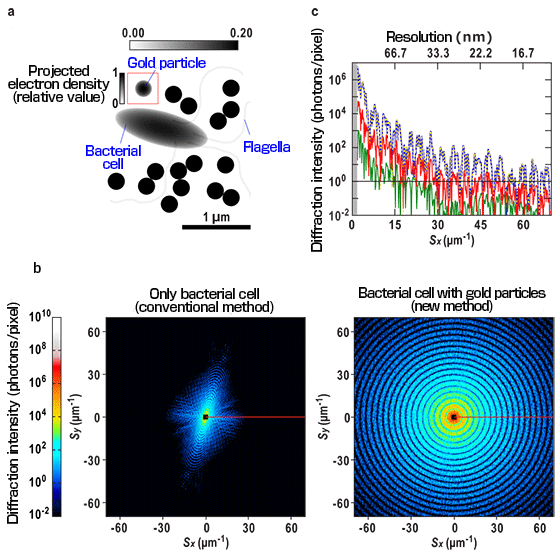Development of High-Resolution and Highly Reliable Imaging Method for Biological Samples -Twofold or greater improvement of resolution under conventional measurement conditions- (Press Release)
- Release Date
- 29 Jan, 2015
- SACLA BL3
RIKEN
|
A joint research group (RIKEN SPring-8 Center and Keio University) has developed a measurement and analysis method that can significantly improve the resolution and reliability of imaging of biological samples, such as cells, using coherent X-ray diffraction imaging (CXDI)*1, and demonstrated that resolution is improved by a factor of two or more by computer simulations. The work was carried out by Yuki Takayama (special postdoctoral researcher), Koji Yonekura (associate chief scientist) et al. of the Biostructural Mechanism Laboratory, RIKEN SPring-8 Center, and the group of Keio University. Publication: |
<<Figures>>
Sample particles dispersed on thin carbon film were irradiated with XFEL pulses to record the diffraction patterns using a two-dimensional detector. In the XFEL irradiation area, X-ray signals are explosively scattered after diffraction, and diffraction patterns are collected while moving the sample. A region within an extremely small angle in the diffraction patterns cannot be observed because of a beamstop that protects the detector from intense X-ray pulses.
With the new method, a sample bacterium with many dispersed gold particles (a) is prepared and irradiated with XFEL pulses. In the diffraction pattern obtained from this sample (b, right), a diffraction pattern with a high intensity is observed for a diffraction angle more than twofold larger than that in the case of the diffraction pattern with the bacterium alone (b, left). The resolution is approximately 14 nm at the periphery. (c) Intensity profile along the red horizontal line in the diffraction pattern. The curves are as follows: blue solid line, the entire sample; yellow dotted line, the gold particles; green solid line, the bacterium; and the red solid line, the interference signal (absolute value) between the two. Because of the interference, the diffraction signal from the bacterial cell was confirmed to be enhanced by one order of magnitude. The signal originating from the gold particles contributes approximately 80% to the total signal and mostly overlaps the plot for the entire sample. Computer simulations are based on CXDI experiments using SACLA carried out by the joint research group.
The density map reconstructed by the new method (right) accurately reproduces even flagella (indicated by arrows) inside and outside the bacterial cell compared with that reconstructed from the same bacterial image by the conventional method (left). The resolution was calculated to be 13 nm, which is higher than that of the conventional method (29 nm) by more than a factor. Projected electron density (relative value)
<<Glossary>>
*1 Coherent X-ray diffraction imaging (CXDI)
Imaging method utilizing the scattering phenomenon of X-rays. When a sample is irradiated with spatially coherent X-rays, a characteristic pattern (X-ray diffraction pattern) that reflects the sample structure is observed. The sample structure can be reconstructed from the diffraction pattern, when the pattern is recorded at a finer interval than a given value on the detector.
*2 X-ray free electron laser (XFEL)
Pulse laser in an X-ray region realized by the recent development of accelerator technology. Unlike conventional lasers using semiconductors and gases as the oscillation medium, XFEL uses electron beams that travel at a high speed in vacuum and has theoretically no restrictions on the wavelength used.
*3 SACLA
Japan’s first XFEL facility constructed jointly by RIKEN and Japan Synchrotron Radiation Research Institute. As one of the five national key technologies, the technology center was constructed and developed in a five-year project starting from FY 2006. It was completed in March 2011 and named SACLA taken from the initial letters of SPring-8 Angstrom Compact Free Electron LAser. The first successful generation of an X-ray laser occured in June 2011. Public operations began in March 2012. SACLA generates highly intense and highly coherent X-rays required for CXDI as very short (fs) pulses.
|
For more information, please contact: |
- Current article
- Development of High-Resolution and Highly Reliable Imaging Method for Biological Samples -Twofold or greater improvement of resolution under conventional measurement conditions- (Press Release)



